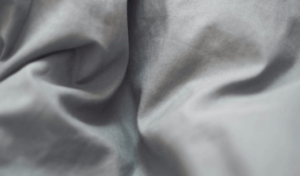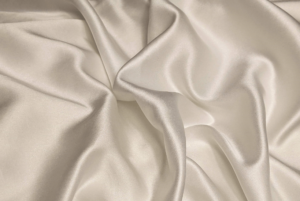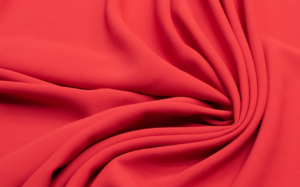Modal Fabric Guide (Everything You Need to Know)

Ammy Harryy, a devoted advocate for sustainable fashion and mindful…
If you’re a maker, you’ve probably come across modal. It’s a versatile and strong material that’s perfect for a variety of projects.
This guide will teach you all about how to work with modal fabric, from its properties to the best ways to cut and sew it.
So whether you’re just starting out or looking to expand your knowledge, read on for everything you need to know about this amazing fabric!
What is Modal Fabric?
Modal is a type of rayon, which is a semi-synthetic fiber. Modal rayon is made from cellulose that has been treated with a solution of sodium hydroxide and then processed with carbon disulfide to form a viscous solution known as sodium cellulose xanthate.
The solution is then forced through a spinneret, which is a metal plate with tiny holes, and the resulting fibers are passed through a bath of sulfuric acid.
This process causes the fibers to swell and become more elastic. The fibers are then washed and dried, and the resulting yarn can be used to make fabric.
Modal is similar to other types of rayon, but it is more durable and has a higher moisture-absorbing capacity. It is often used in sportswear and intimate apparel because of its softness and comfort.
Modal fabric can be made from either wet or dry spinning, but it is most commonly made from wet spinning because it yields a more uniform product.
The production of modal fabric involves several steps, but the overall process is relatively simple and does not require high temperatures or harsh chemicals. As a result, it is considered to be environmentally friendly.
The resulting fabric is extremely soft and has a silky texture. It is also highly absorbent, making it ideal for use in clothing such as underwear and baby clothes.
Modal is also often used in bedding and home furnishings because of its ability to resist wrinkles and static. Thanks to its many desirable properties, modal has become one of the most popular types of fabric in the world.
History of Modal
The history of Modal began in the early 2000s when an Austrian company Lenzing developed a new type of plant-based textile.
The company wanted to create a more sustainable alternative to conventional cotton, and they succeeded in developing a fabric that was both soft and durable.
Lenzing soon began selling the fabric under the brand name “Modal.” The fabric quickly caught on in the fashion industry, and it is now used in a wide range of garments, from t-shirts to underwear.
Modal is also becoming increasingly popular in the home furnishing market, as it is perfect for bedding and towels.
Thanks to its many benefits, Modal is quickly becoming one of the most popular plant-based textiles on the market.

Is Modal Fabric Sustainable?
Modal is a sustainable fabric made from beech trees. The production process of modal is similar to that of viscose rayon, except that it uses fewer chemicals and produces less pollution.
Modal is also more durable than viscose rayon, making it a good choice for clothing that will be worn often.
Because modal is made from renewable resources, it is an environmentally friendly alternative to other fabrics such as cotton and polyester.
Modal is also soft and breathable, making it comfortable to wear in all seasons. When choosing modal fabric for your clothing, you can be confident that you are making a sustainable choice that will help to protect our planet.
What Makes Modal a Sustainable Option?
As a sustainable materials, Modal has a number of advantages over other materials.
Firstly, it is inherently sustainable. Modal is made from the cellulose of beech trees, which are a renewable resource.
Secondly, the production process of Modal is environmentally friendly. The fabric is produced using a closed-loop solvent system, which conserves water and energy.
Finally, Modal is durable and long lasting. This means that it doesn’t need to be replaced as often as other fabrics, which reduces the environmental impact of clothing production.
Taken together, these factors make Modal a highly sustainable option for clothing manufacture.
How is Modal turned into a Fabric?

Let’s discuss the modal production process! Modal is a high wet modulus rayon, meaning that it is a durable fabric that can withstand repeated washings and wearing.
Unlike other natural fabrics such as cotton, Modal does not shrink or stretch over time.
This makes it an ideal fabric for both everyday clothing and activewear.
In addition to its durability, Modal is also a soft and comfortable fabric. It is often used in garments such as underwear and pajamas because of its luxurious feel.
Because of its many desirable qualities, Modal is a popular choice for both designers and consumers.
The Pros of Modal
Modal is a semi-synthetic fabric made from the pulp of beech trees. It is 50% more absorbent than cotton, making it ideal for people with sensitive skin.
Modal is also an eco-friendly alternative to conventional fabrics like polyester and nylon.
In addition, Modal is one of the most luxurious fabrics on the market. It has a soft, silky feel that is similar to silk.
However, unlike silk, Modal is resistant to shrinking and fading. As a result, it is an ideal fabric for clothing that will be worn frequently.
The Cons of Modal
While modal is soft and comfortable, it also has some drawbacks. One issue is that modal is prone to shrinkage.
This can be a problem when washing modal fabrics, as they may shrink more than other types of fabric.
Additionally, modal is not as resistant to wrinkling as other fabrics, so it may need to be ironed more often.
Finally, modal fabric is not as durable as some other materials, so it may wear out more quickly over time. Allergic reactions are another potential concern with modal fabrics.
Some people may experience allergic reactions to the chemicals used in the manufacturing process.
Additionally, chlorine bleach should not be used on modal fabrics, as it can damage the material.
Despite these drawbacks, modal remains a popular choice for many people due to its softness and comfort.
Modal Clothing Brand
Modal is a type of fabric made from beech trees. The process of making modal fabric is sustainable, as it uses far less water and creates far fewer emissions than traditional methods of creating viscose rayon.
Modal is often used in athletic wear because it is extremely soft and breathable.
Modal is a type of fabric that is often used in clothing. Some popular brands that use Modal clothes include:
- Abercrombie & Fitch
- Calvin Klein
- Eddie Bauer
- Gap
- J.Crew
- Lucky Brand
- Old Navy
- Tommy
Whether you’re looking for modal underwear, yoga pants, bed sheets, or a modal t-shirt, there’s a modal clothing brand that can meet your needs.
Look for a brand that uses sustainably sourced modal and that offers a wide range of sizes so that you can find the perfect fit.
The Impact of Modal

Modal is a low to medium heat set fabric made from the pulp of the beech tree. The wood is dissolved in sodium hydroxide, and the resulting solution is forced through a screen with a very tight weave.
The rayon fabric that results has a number of properties that make it ideal for certain uses.
First, it is very strong and durable. Second, it is resistant to shrinkage and fading.
Finally, it has a soft, silky feel that makes it comfortable to wear. Modal is often used in sportswear and activewear because it can withstand repeated washings and still retain its shape and color.
It is also popular in bedding and towels because of its softness and absorbency.
Thanks to its many desirable properties, Modal is sure to continue to be a popular choice for fabric production.
Impact of Modal on planet
There’s no denying that the planet is in trouble. greenhouse gas emissions are rising, and the effects of climate change are becoming more and more evident.
One small way to help mitigate these problems is to choose environmentally friendly fabrics, like modal. Modal is made from sustainably sourced wood pulp, and it’s completely biodegradable.
That means when you’re done with your clothes, they’ll decompose without harming the environment. In addition, modal is incredibly soft and durable, making it the perfect fabric for everything from t-shirts to bedding.
So next time you’re doing some shopping, look for environmentally friendly fabrics like modal – your planet will thank you for it!
Impact of Modal on animal and people
The Impact of Modal on animal and people has been low to medium heat. The beech tree is a source of raw material for the production of cellulose fibers such as modal.
In the past, the use of sodium hydroxide was necessary to dissolve the cellulose in order to produce rayon fabric, but today, new technologies have been developed that make it possible to produce a tight weave without this caustic chemical.
As a result, modal is now considered to be a safer alternative to traditional rayon fabric.
In addition, modal is also more absorbent than other types of cellulose fibers, making it ideal for use in clothing and other products that come into contact with skin.
Conclusion
So, what is a modal? In short, it’s a material that can change the way light reflects off of it.
This makes it the perfect tool for creating optical illusions and adding intrigue to your designs.
By understanding how to use these materials, you can create beautiful pieces that stand out from the competition.
More Sustainable Guide You’ll Love to read:
Apple Leather Fabric Guide (Everything You Want to Know)
Sustainable Viscose Fabric Material Guide
Seacell Fabrics Material Guide For Fashion Designer
Cork leather, a Sustainable material?
Wool Fabric Guide, Everything you need to know
Get to know about Econyl Fabric
Vegetable Tanned Leather Material Guide
A Details Guide On Silk Fabric Material
A Details Guide On Down Fabric Material
What Is Camel Fabric,How It Made?(Everyhing You Want To Know)
Details Material Guide On Cashmere Fabric
What is Alpaca Wool Fabric? History, How It’s Made
Recycled Polyester Fabric Details Guide
Cupro Fabric Material Guide (Is It Sustainable?)
Woocoa Fabric Material Guide (Why It’s Expensive)
Organic Bamboo Fabric Guide (Eco Friendly
Sustainable Ecovero Fabric Material Guide (All Details)
Details Material Guide On Pinatex Fabric
A Details Guide To Scoby Leather Fabric
Ammy Harryy, a devoted advocate for sustainable fashion and mindful living, exudes a profound passion for nature and the environment. Her mission intertwines style and consciousness, inspiring eco-friendly choices. With her words, Ammy envisions a world where fashion harmonizes with the planet, urging readers to take small steps toward a greener future.



